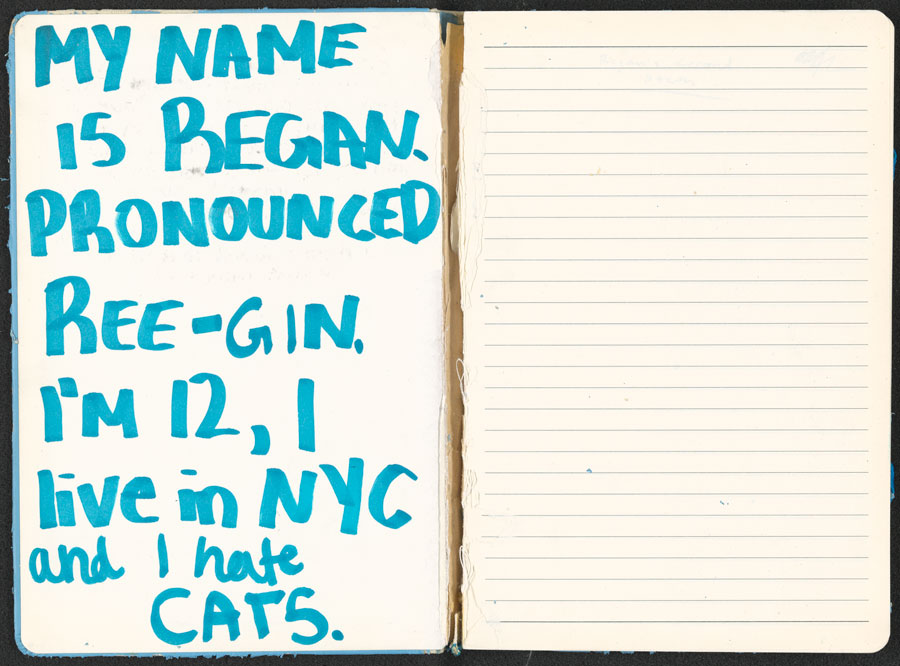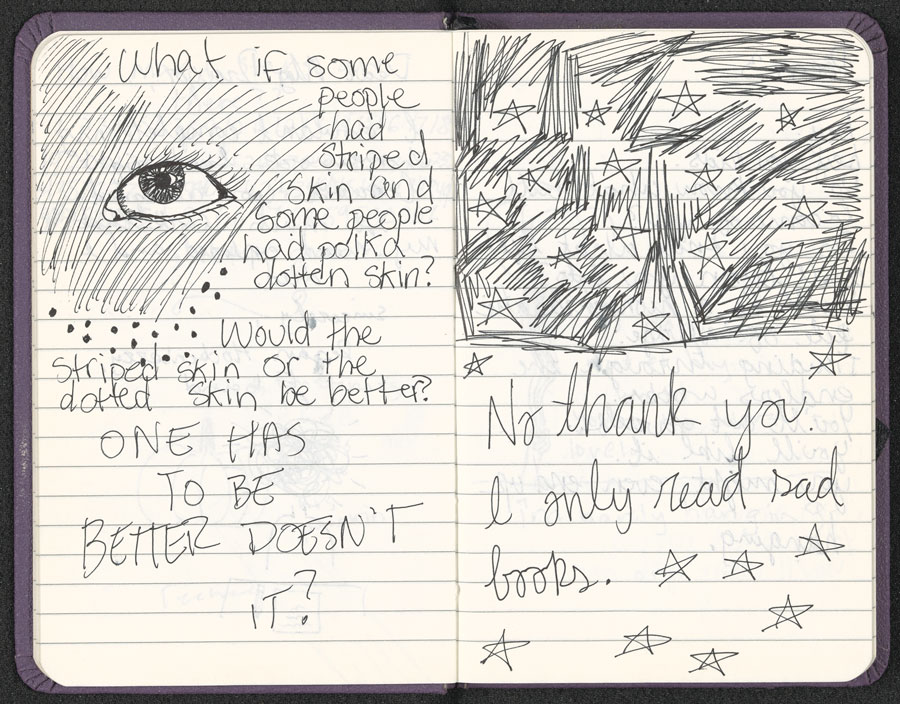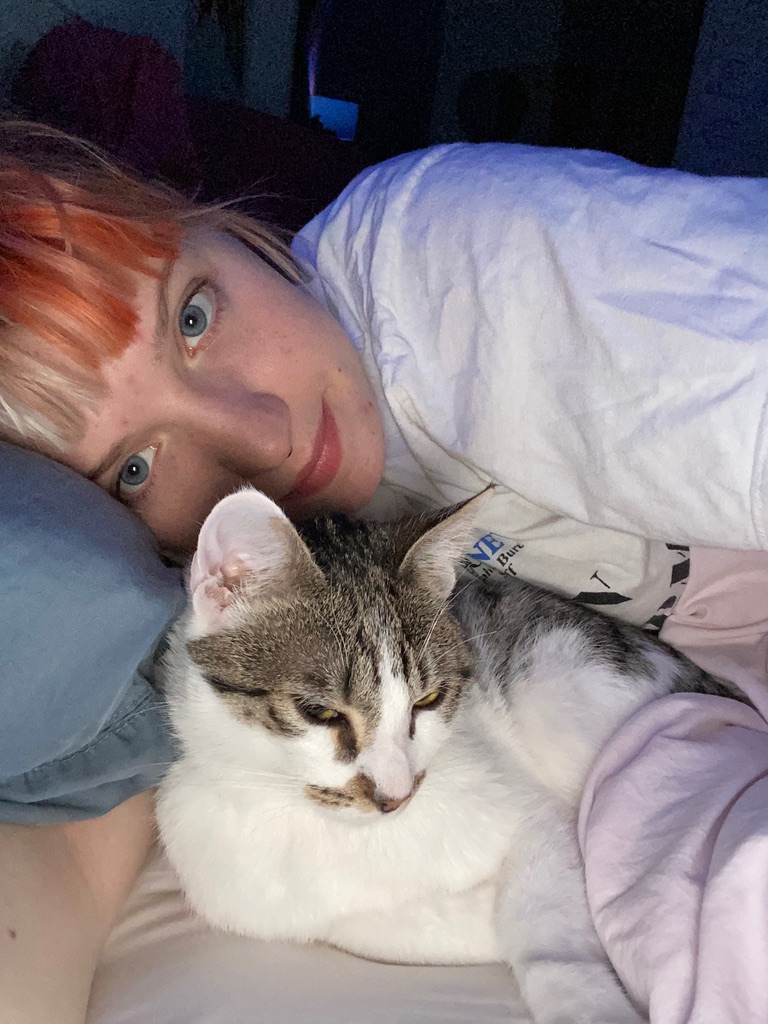“I was thrilled to find you and I was even more thrilled to realize that there actually was a compassionate institution on the other end. That’s what I’m interested in showcasing.”
—John Hockenberry on why he agreed to an interview about this project.
Preserving the creative legacy of a daughter
John reached out to Anderson Archival in May of 2025 with an emotional request.
“As far as the particular story of my daughter, she’s deceased. We would have to say that. Regan died as a part of the fentanyl crisis.”
Regan, a diarist, poet, song writer, and artist left behind an extensive archive, affectionately referred to as her “Collected Papers.” As the grieving family approached the anniversary of Regan’s passing, it was imperative that her archive be shared and experienced by her family.
“The value of your service in preserving the record of her emotional pathway… is now a very precious part of our common family artifacts and the record of our family love,” John says. “When you have someone who is as talented and creative as our daughter Regan was, there’s an archive of material. A college student, a vagabond character… she traveled and struggled and lived in many places. She dragged around in a box all of her journals from a long time ago and songs, recordings, lyrics, and things that she wrote.”
The family was aware of the collection Regan left behind, but who would keep it? Why should only one person hold her collected materials?
“We don’t want it to just be in a box somewhere, off limits, that no one will ever get to see. There was a real quandary in figuring out how we honor this material, make it accessible to the people in the family who need to see it, and in my particular case, who not only needs to see it, but wants to refer back to it,” John says. “There are family members who will probably never look at it but are very happy that they have it.”

For such an important collection, finding the right digitization partner was essential.
John needed to “find somebody who can recognize the value of the material, preserve it in a way that’s both accessible and conveys the sense of intensity both in the writing and the artwork, and has the technology to produce digitized images that have enough resolution to deal with a variety. Some stuff is pencil written, some is really old and wrinkly. The copying machine at FedEx was not an option here. I went to a lot of different places who claimed they did what [Anderson Archival] did, and clearly, they didn’t. And they didn’t have the capacity to do it. I knew immediately talking to you that I was in a different place and that you understood exactly what it was I needed.”
Digitizing the collection had benefits beyond just preservation and access.
“I always worry when I’m going through the physical that there’s a limited number of times that I can do this before it wears away. You can get a sense of time passing and that this journal, which was easily readable a month ago, you can see the effects of time on it. One of the things the digitizing process did was make me feel absolutely clear about the preservation of the real artifacts. Not having to open that box to experience the material is really important for the long-term preservation of that material.”
The essence of Regan, every part of her, shines through in the collection.

“I think the things that are most moving to me are the drawings and some of the stuff that is whimsical. There are images that she just dashed off that come from an interior world that I can only imagine, I can only speculate about, even though I lived all her life with her as a dad. Those things, I think, say a lot about her.
“She was so interested in, ‘Why am I here? What am I doing here? What am I supposed to do?’ She had a real visceral sense of this living thing. She had a sense of curiosity from a very early age and that is scattered throughout her diaries. I think she’s so candid. She’s just so candid and honest.
“What I love, she talks a lot about her fights with her siblings and her critiques of her parents. You are getting a snapshot of a teenager. Some of the material that I return to most are the ones where she’s ranting at me on the page.
“I wish she was here to rant at me now.”

While the Anderson Archival team never knew Regan in life, we connected with her through this afterimage.
“One of the things we conveyed to Regan was the value of writing it down, taking the action to record her thoughts, whether it be in journals or writing songs or making drawings, of making sure that there were living, tangible records of some of her thoughts and passions. I’m just glad that whatever she was going through, she understood the importance of writing it down.”
Every collection we work on at Anderson Archival holds a connection to the people involved. This project made it clear that digitization stands as connective tissue between the original creator and those viewing the digital files.
“All I would say to you is that I hope you will consider the success with this project as an argument for why your business is, in a sense, a stewardship for the preservation of artifacts. It reminds us of the value of these things. A depiction of the value of these treasures that you’re preserving hopefully encourages people to make sure that they are keeping this stuff and putting it together.
“This taught me that, you know, Regan is no longer here,” John concludes, “but because of you and because of my determination, and her impulse to actually write, there’s an immortality to that.”

All images used with permission


